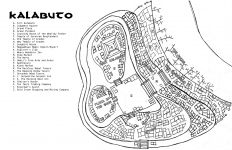So last session of my PF2e game, the party arrived in the city of Kalabuto… which has no city map anywhere. So, based on the single picture of Kalabuto I could find, I made one (attached). The transition from traveling overland to exploring the city was incredibly smooth as I was able to just put down the city map, put the character’s minis on it, and start the exploration. The session was a blast as they began to try and unravel the mysteries of Kalabuto (we’re playing a mashup of Carrion Hill, Cult of The Reptile God, and Dawn of the Scarlet Sun), though in retrospect, I don’t think that I conveyed to some the players just how populated Kalabuto was; they kept expecting people to know everyone else in town and getting confused when they didn’t. For the next session I am going to be sure to emphasis the number of people in the district descriptions.
I am also going to implement a simple factional activity system (in preparation for a more detailed scenario later in which multiple factions will be competing to explore a lost city). I included it as well though it is more of a sketch at this point.
Finally, with the release of Bestiary 3 and the troop template… I rebuilt some of the expedition’s NPC to interact with the system. Basically, I built the expedition as a troop with the minion trait, and some of the followers the characters acquire through the Leadership subsystem can add abilities to the troop. For example: the medic gives the troop the ability to heal themselves, the lieutenant gives the troop actions even when the PC leader doesn’t, and the bomber alchemist allows bomb volleys once per day.



